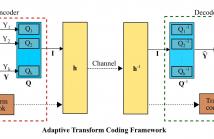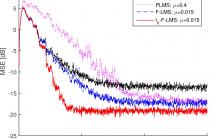
- Read more about Orthonormal Matrix Codebook Design for Adaptive Transform Coding
- Log in to post comments
A novel algorithm for designing optimized orthonormal transform-matrix codebooks for adaptive transform coding of a non-stationary vector process is proposed. This algorithm relies on a block-wise stationary model of a non-stationary process and finds a codebook of transform-matrices by minimizing the end-to-end mean square error of transform coding averaged over the distribution of stationary blocks of vectors.
- Categories:
 38 Views
38 Views
- Read more about poster--ROBUST VISUAL OBJECT TRACKING WITH SPATIOTEMPORAL REGULARISATION AND DISCRIMINATIVE OCCLUSION DEFORMATION
- Log in to post comments
Spatiotemporal regularized Discriminative Correlation Filters (DCF) have been proposed recently for visual tracking, achieving state-of-the-art performance. However, the tracking performance of the online learning model used in this kind methods is highly dependent on the quality of the appearance feature of the target, and the target feature appearance could be heavily deformed due to the occlusion by other objects or the variations in their dynamic self-appearance. In this paper, we propose a new approach to mitigate these two kinds of appearance deformation.
- Categories:
 15 Views
15 Views
- Read more about Social Learning Under Inferential Attacks
- Log in to post comments
- Categories:
 12 Views
12 Views
- Read more about NORMALIZED LEAST-MEAN-SQUARE ALGORITHMS WITH MINIMAX CONCAVE PENALTY
- Log in to post comments
We propose a novel problem formulation for sparsity-aware adaptive filtering based on the nonconvex minimax concave (MC) penalty, aiming to obtain a sparse solution with small estimation bias. We present two algorithms: the first algorithm uses a single firm-shrinkage operation, while the second one uses double soft-shrinkage operations. The twin soft-shrinkage operations compensate each other, promoting sparsity while avoiding a serious increase of biases. The whole cost function is convex in certain parameter settings, while the instantaneous cost function is always nonconvex.
- Categories:
 160 Views
160 Views
- Read more about Indoor Altitude Estimation of Unmanned Aerial Vehicles Using a Bank of Kalman Filters
- Log in to post comments
Altitude estimation is important for successful control and navigation of unmanned aerial vehicles (UAVs). UAVs do not have indoor access to GPS signals and can only use on-board sensors for reliable estimation of altitude. Unfortunately, most existing navigation schemes are not robust to the presence of abnormal obstructions above and below the UAV.
- Categories:
 51 Views
51 Views
- Read more about Feature Affine Projection Algorithms
- Log in to post comments
There is a growing research interest in proposing new techniques to detect and exploit signals/systems sparsity. Recently, the idea of hidden sparsity has been proposed, and it has been shown that, in many cases, sparsity is not explicit, and some tools are required to expose hidden sparsity. In this paper, we propose the Feature Affine Projection (F-AP) algorithm to reveal hidden sparsity in unknown systems. Indeed, first, the hidden sparsity is revealed using the feature matrix, then it is exploited using some sparsity-promoting penalty function.
- Categories:
 23 Views
23 Views
The huge volume of data that are available today requires data-
selective processing approaches that avoid the costs in computa-
tional complexity via appropriately treating the non-innovative data.
In this paper, extensions of the well-known adaptive filtering LMS-
Newton and LMS-Quasi-Newton Algorithms are developed that
enable data selection while also addressing the censorship of out-
liers that emerge due to high measurement errors. The proposed
solutions allow the prescription of how often the acquired data are
- Categories:
 21 Views
21 Views
- Read more about A Characterization of Stochastic Mirror Descent Algorithms and Their Convergence Properties
- Log in to post comments
Stochastic mirror descent (SMD) algorithms have recently garnered a great deal of attention in optimization, signal processing, and machine learning. They are similar to stochastic gradient descent (SGD), in that they perform updates along the negative gradient of an instantaneous (or stochastically chosen) loss function. However, rather than update the parameter (or weight) vector directly, they update it in a "mirrored" domain whose transformation is given by the gradient of a strictly convex differentiable potential function.
- Categories:
 48 Views
48 Views
- Categories:
 25 Views
25 Views
- Read more about l0-norm Feature LMS Algorithms
- Log in to post comments
A class of algorithms known as feature least-mean-square (FLMS) has been proposed recently to exploit hidden sparsity
- Categories:
 83 Views
83 Views